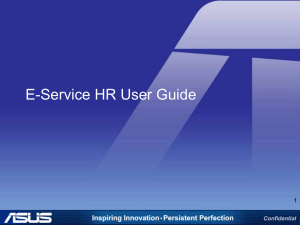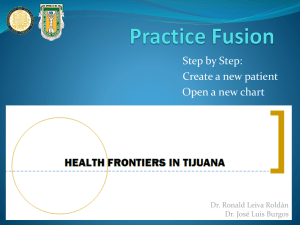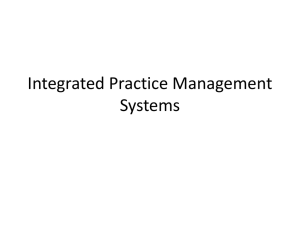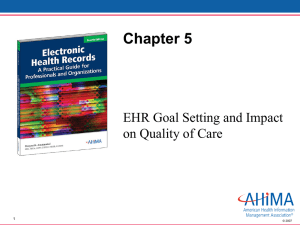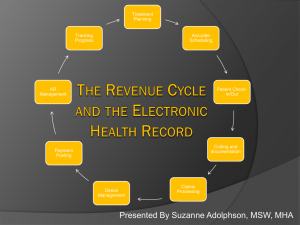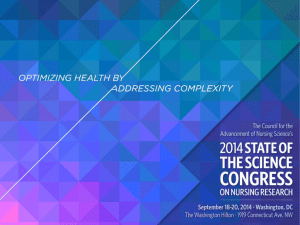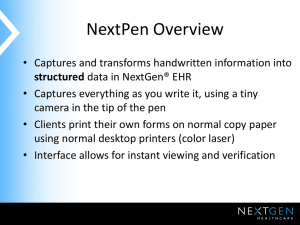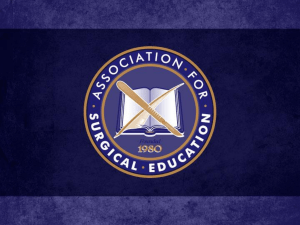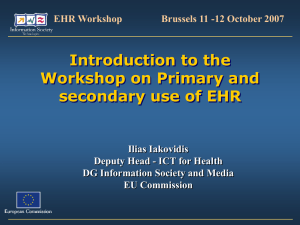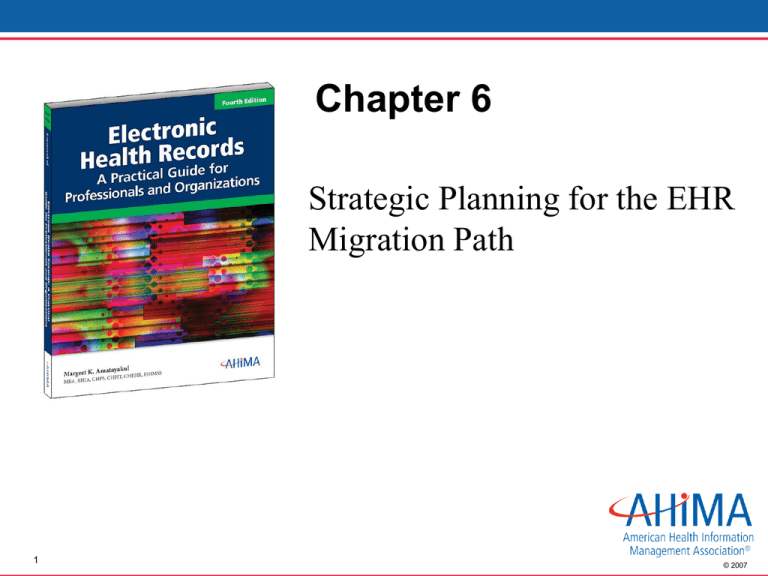
Chapter 6
Strategic Planning for the EHR
Migration Path
1
© 2007
EHR Migration Path
• Because an EHR is a journey toward goals for
clinical transformation aided by technology, a
high level view of the journey is needed
• A migration path identifies the applications,
technology, and operational elements needed to
accomplish an organization’s EHR goals along a
specified timeline
© 2007
Gartner Generations
• One of the most widely recognized descriptions
of a pathway to an EHR
© 2007
Generations
• Collector
– Clinical data display/results retrieval
• Documenter
– Data capture at point of care
– Simple documentation tools
– CPOE with alerts in near-to or real time
© 2007
Generations
• Helper
–
–
–
–
–
–
More advanced EHR systems
Decision support
Patient care charting
Integration of functions
Knowledge management
Integration with “extranet”
© 2007
Generations
• Partner
– Advanced systems with complex decision support
– Links to PHR
• Mentor
– Most complex
– Fully integrated across continuum of care
– Highly advanced knowledge management,
decision support, and predictive modeling
© 2007
Strategic Planning
• Strategic planning consists of the process of
defining goals and developing strategies to reach
those goals with specific milestones
• Determines for an organization:
– Where it is going over the next several years
– How it is going to get there
– How it will know whether it got there
© 2007
The EHR Pathway
• Strategic plan: establishes the framework
within which an EHR will be adopted
– Migration path: provides a high level view of the
pathway toward putting the components together
• Implementation plan: identifies timeline and
accountability for performing detailed tasks to
implement any given component of an EHR
– Transition strategy: how each component
of an EHR will be rolled out
© 2007
Conducting Strategic Planning
•
•
•
•
•
Determine approach
Conduct every one to three years
Conduct in a retreat environment
Executive management team and other resources
Use facilitator to overcome bias and group process
pressures
• Prepare perspectives or analysis in advance
• Develop a written plan, with objectives, responsibilities,
time line, etc.
© 2007
Traditional Approach to Strategic Planning
Preparation
Who, when, where,
why, how
Strategic
Analysis
Environmental scan
SWOT
Organizational assessment
Strategic
Direction
Mission, vision, values
Strategic goals/initiatives
Action plans
Process
Evaluate planning process
Acknowledge completion
© 2007
Strategic Planning for EHR
• Determine interest in advance
– User readiness
– Attitudes and beliefs survey
• Construct a briefing paper
–
–
–
–
Outline a definition
Illustrate the notion that EHR will be built over time
Fairly outline costs and benefits
Accurately reflect current level of interest,
understanding, and readiness
© 2007
Strategic Planning Models
• Basic
– Small organizations
• Issue-based
– For experienced planners
• Alignment
– Organizations with internal inefficiencies
• Scenario
– As part of major change in direction
• Organic
– Self-organized approach
© 2007
EHR Migration Path Models
© 2007
Migration Path Template
•
•
•
•
•
©2006 All rights reserved.
Time frame
Goals
Applications
Technology
Operations
© 2007
Time Frame and Goals
• Overall period for EHR implementation
– Can be broken down into phases initially
– Many paths are several years long,
• Often with phases lasting 1 to 3 years each
• Goals
– Cluster goals according to each phase and provide a
summary statement
– Attach the complete set of goals to the migration path
document
© 2007
Applications
• Group by:
– Financial/administrative
– Operational
– Clinical
• List all current applications, then planned applications as
they may be related to each other
• Consider acquisition strategy for applications:
– Best of breed
– Best fit
– Dual-core
© 2007
Acquisition Strategy
Best of Fit
One primary vendor
Dual Core
Two primary vendors
Best of Breed
Many vendors
•Financial/Administrative
•Operational or Clinical
Small hospitals
Standardization
Both moving to this
strategy
Large standalone or
academic centers
Simpler to implement
and maintain
Consolidation or way
to achieve
comprehensive EHR
•Difficult to implement
and maintain
•Interface
requirement
© 2007
Technology
• Describe current technology:
–
–
–
–
–
Database structure
Network and infrastructure
Interoperability strategies
Human-computer interfaces
Storage
• Identify new and/or upgrades needed
© 2007
Operational Elements
• Need to support:
–
–
–
–
–
Planning
Selection
Implementation
Adoption
Benefits realization
• Must address:
– People
– Policies
– Procedures
© 2007
Critical Success Factors
•
•
•
•
•
•
•
•
Create a vision
Identify the planning horizon
Gain agreement
Develop a funding and acquisition strategy
Develop functional, data, and technical strategies
Carry out a vendor selection process
Plan implementation
Conduct benefits realization
© 2007
Different Care Settings
• Acute versus ambulatory
• Other (e.g., nursing home, home health, dental,
mental health)
• Academic versus community
• Managed care versus fee for service
• For-profit versus nonprofit
© 2007
Conclusion
• Tipping point for EHR is when strategic planning
recognizes the supporting role the EHR places in
every planning component
• Strategic planning provides a clearly defined
migration path, which is then used to direct more
focused planning and detailed tactical plans
© 2007


